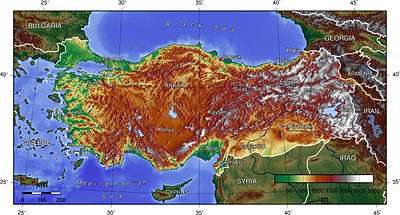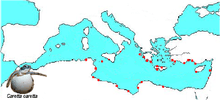Wildlife of Turkey
The wildlife of Turkey is abundant and very varied. Turkey is a large country with many geographic and climatic regions and a great diversity of plants and animals, each suited to its own particular habitat. About 1500 species of vertebrates have been recorded in the country and around 19,000 species of invertebrate. There are about 11,000 species of flowering plants; some of the world's staple crops were first cultivated in this area, and many of their wild relatives are still found here. The country acts as a cross roads with links to Europe, Asia and the Near East, and many birds use the country as a staging post during migration.
Ecoregions

The geography of Turkey is roughly rectangular, being more than 1,600 km (990 mi) east-west and 800 km (500 mi) north-south. Turkey's 783,562 km2 (302,535 sq mi) of land is divided into two parts by the Bosphorus, the Sea of Marmara and the Dardanelles; European Turkey makes up only 3% of the country, with the rest being in Asia and often known as Anatolia.
The country has varied topography with fertile coastal plains contrasting with mountainous regions in the centre and eastern part of the country. The climate of Turkey also varies, with the weather systems found near the coasts contrasting with those prevailing in the interior. The Aegean and Mediterranean coasts have hot, fairly dry summers and cool, rainy winters. The interior of the country has a continental climate with severe weather on the Anatolian plateau in winter, and hot, dry summers. These large differences in climate are reflected in an extremely diverse flora and fauna.[1]
The ecoregions of Turkey include the important[2] terrestrial Eastern Anatolian deciduous forests and Southern Anatolian montane conifer and deciduous forests.
Turkey includes portions of three biodiversity hotspots: the Mediterranean Basin, the Caucasus, and the Irano-Anatolian.[2]
Flora
In the whole of Turkey there are about 11,000 species of flowering plant, about a third of which are endemic to the country. This area played a key role in the early cultivation of wheat, other cereals and various horticultural crops.[1] The country is divided into three main floristic areas; the Mediterranean area; the Euro-Siberian area; and the Irano-Tranian area.[3] The flora of the European part of Turkey is similar to that of adjoining Greece. The ecoregions here include Balkan mixed forests dominated by oaks and containing Scots pine, Bosnian pine, Macedonian pine, silver fir and Norway spruce,[4] and Aegean and Western Turkey sclerophyllous and mixed forests where some of the main species are oaks, strawberry tree, Greek strawberry tree, Spanish broom and laurel.[5]
The Euro-Siberian area is a mountainous part of western Turkey. Here the flora transitions from the Mediterranean vegetation type to the Anatolian plateau. The dominant vegetation cover here is forests of oak and pine, especially Anatolian black pine and Turkish pine.[6] Further east is the Anatolian plateau, a largely treeless area of plains and river basins at an average altitude of 1,000 m (3,300 ft). This area is characterised by hot dry summers and cold winters. Salt steppes and lakes are found here, as well salt-free grassland areas, marshes and freshwater systems. Immediately around the large Lake Tuz and other saline areas, saltmarsh plants grow, and beyond this is a sharp divide, with the flora being dominated by members of the families Chenopodiaceae and Plumbaginaceae.[7]
The mountainous eastern half of the country is separated floristically from the rest of the country by the Anatolian diagonal, a floral break that crosses the country from the eastern end of the Black Sea to the northeastern corner of the Mediterranean Sea. Many species found to the east of this break are not found to the west and vice versa, and about four hundred species are only found along this divide.[8] The natural vegetation in eastern Turkey is the Eastern Anatolian deciduous forests; in these oaks such as Brant's oak, Lebanon oak, Aleppo oak and Mount Thabor's oak predominate in open woodland with Scots pine, burnet rose, dog-rose, oriental plane, alder, sweet chestnut, maple, Caucasian honeysuckle (Lonicera caucasica) and common juniper.[9]
Fauna

Turkey has a large range of habitat types and a great faunal diversity. Nearly 1,500 vertebrate species were recorded, of which over 100 species, mostly fish, are endemic. The country is on two major routes used by migratory birds which increase in numbers during spring and autumn. The invertebrate fauna is also very diverse, with about 19,000 species being recorded including 4,000 endemics.[10]
Fungi
There are over 12,000 varieties of mushroom in Turkey.[11]
Threats
Threats to biodiversity include desertification due to climate change in Turkey,[12] which is forecast to move the ecoregions northwards,[13] and large scale infrastructure projects such as those near Istanbul.[14]
Policy
The government plans to increase protected areas from the 9% in 2019 to 17% by 2023.[15] There are restrictions on access to environmental information.[16]
See also
References
- Muminjanov, H.; Karagöz, A. (2018). Biodiversity of Turkey: Contribution of Genetic Resources to Sustainable Agriculture and Food Systems. Ankara: Food and Agriculture Organization of the United Nations. ISBN 978-92-5-130959-9.
- "Animals and Plants Unique to Turkey". lntreasures.com. Retrieved 2019-06-15.
- "Turkey's Flora". All about Turkey. Retrieved 19 November 2015.
- "Eastern Europe: Turkey, Greece, Macedonia, Bulgaria, Romania, and Serbia: Temperate broadleaf and mixed forest". World Wildlife Fund. Retrieved 20 November 2015.
- "Southeastern Europe: Along the coastline of Greece and Turkey, stretching into Macedonia: Mediterranean forests, woodlands and scrubs". World Wildlife Fund. Retrieved 20 November 2015.
- "Southeastern Europe: Western Turkey: Mediterranean forests, woodlands and scrubs". World Wildlife Fund. Retrieved 20 November 2015.
- "Western Asia: Central Turkey: Temperate grasslands, savannas and shrublands". World Wildlife Fund. Retrieved 20 November 2015.
- Öztürk, M.; Hakeem, K. R.; Faridah-Hanum, I.; Efe, R. (2015). Climate Change Impacts on High-Altitude Ecosystems. Springer. p. 100. ISBN 978-3-319-12859-7.
- "Turkey: Temperate broadleaf and mixed forests". World Wildlife Fund. Retrieved 20 November 2015.
- Biodiversity in Turkey. IUCN. 2012.
- Team, The Guide (2018-09-10). "Fungi season: wild mushrooms in Turkey". The Guide Istanbul. Retrieved 2019-06-15.
- Kazancı, Nizamettin; Kuzucuoğlu, Catherine (2019), Kuzucuoğlu, Catherine; Çiner, Attila; Kazancı, Nizamettin (eds.), "Threats and Conservation of Landscapes in Turkey", Landscapes and Landforms of Turkey, World Geomorphological Landscapes, Springer International Publishing, pp. 603–632, doi:10.1007/978-3-030-03515-0_36, ISBN 9783030035150
- Ergüner, Yasemin; Kumar, Jitendra; Hoffman, Forrest M.; Dalfes, H. Nüzhet; Hargrove, William W. (2019-01-01). "Mapping ecoregions under climate change: a case study from the biological 'crossroads' of three continents, Turkey". Landscape Ecology. 34 (1): 35–50. doi:10.1007/s10980-018-0743-8. ISSN 1572-9761.
- The Northern Forests Defense Activists (January 2019). "THE ECOLOGY STRUGGLE IN THE MEGAPOLIS: DEFENDING THE NORTHERN FORESTS AND THE CITY" (PDF). Saha. Special Issue 2: 39–44. ISSN 2149-7885.
- "More areas to be preserved in bid to keep biodiversity intact". DailySabah. Retrieved 2019-06-15.
- OECD Environmental Performance Reviews: Turkey 2019. www.oecd-ilibrary.org. OECD Environmental Performance Reviews. 2019. doi:10.1787/9789264309753-en. ISBN 9789264309746. Retrieved 2019-06-13.